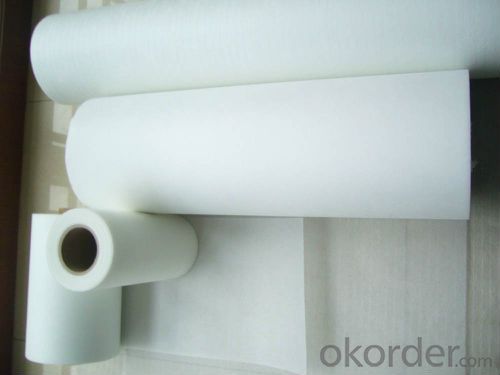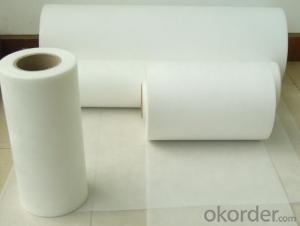Fiber Glass Surface Tissue Mat
- Loading Port:
- China Main Port
- Payment Terms:
- TT or LC
- Min Order Qty:
- 144000 m²
- Supply Capability:
- 1440000M2 Per Month m²/month
OKorder Service Pledge
OKorder Financial Service
You Might Also Like
1.Brief Introduction1.Brief Introduction
Surfacing Tissue mainly used in the surface layers of FRP products. It features even Fiber distribution, soft feel, level and smooth fiber surface, less glue content, quick resin soak and good pattern fitness. It can improve the product surface property on corrosion resistance, compressive strength, seepage resistance, and longer service life. It is also suitable for spraying; pattern pressing and other FRP pattern technology.
2.Characteristics
Fast breakdown in styrene
Fiber dispersed evenly
Low binder content
Superior acid corrosion resistance
3.Specifications
Item | Unit | Specification |
Area Weight | g/m2 | 30+/-3 |
Binder Content | % | 6-9 |
Tensile Strength MD | N/125px | ≥35 |
Soaking time | S | ≤10 |
Moisture content | % | ≤0.5 |
Width length
| mm
| 1270
|
Roll Diameter
| m | 300
|
Special specification can be produce according to customer requirements.

4.FAQ
a.Package
Each Surface Tissue is wound onto a paper tube which has an inside diameter of 76mm and the mat roll has a diameter of 330mm. The mat roll is wrapped up with plastic film,and then packed in a cardboard box or wrapped up with kraft paper. The rolls can be vertically or horizontally placed. For transportation, the rolls can be loaded into a cantainer directly or on pallets.
- Q:How do fiberglass fabrics perform in terms of UV resistance?
- Fiberglass fabrics generally have excellent UV resistance due to the inherent properties of the material. The fibers used in fiberglass fabrics are typically made of glass, which is naturally resistant to UV rays. This resistance allows fiberglass fabrics to withstand prolonged exposure to sunlight without significant degradation or weakening. As a result, these fabrics are often used in outdoor applications where UV protection is crucial, such as in awnings, sunshades, or boat covers.
- Q:What are the different thicknesses available for fiberglass fabric?
- Fiberglass fabric is available in various thicknesses to cater to different applications and requirements. The most common thicknesses range from 0.5 ounces per square yard (osy) to 3.0 osy. However, it is important to note that the thickness of fiberglass fabric is measured in weight per square yard rather than physical thickness. The thinnest fiberglass fabric options, such as 0.5 osy, are often used in applications where a lightweight and flexible fabric is required. These fabrics are commonly used in industries like aerospace, automotive, and marine, where weight reduction and flexibility are crucial factors. On the other hand, thicker options like 1.5 osy to 3.0 osy are typically used for applications that require higher strength and durability. These fabrics are commonly used in industries like construction, insulation, and industrial manufacturing, where a stronger and more rigid material is necessary. It is worth mentioning that fiberglass fabric can also be customized to suit specific thickness requirements. Manufacturers can tailor the fabric's weight per square yard to meet the desired specifications of a particular project. In conclusion, fiberglass fabric comes in various thicknesses, ranging from 0.5 osy to 3.0 osy, to satisfy different applications' needs. The selection of the appropriate thickness depends on factors such as the desired strength, flexibility, weight reduction, and durability required for the specific project or industry.
- Q:What is the advantage of coating waterproof layer with matrix reinforcing material?
- Since the matrix reinforcement material to absorb the paint, retained a part of glue, not to lower flow, but also increased the flow of glue down resistance, play the role of carrier. Therefore, the slope of the roof and facade in the film overlay non-woven fabric or fiberglass cloth, can play a solid glue, adhesive effect, especially some long curing time, low viscosity coating paving a layer of cloth, to ensure the construction quality of the film.
- Q:Can fiberglass fabric be used for insulation blankets?
- Yes, fiberglass fabric can be used for insulation blankets. Fiberglass fabric is known for its excellent thermal insulation properties, making it a popular choice for insulation applications. It is lightweight, flexible, and can be easily molded into the desired shape. Fiberglass fabric is also resistant to high temperatures, chemicals, and moisture, making it suitable for use in various industrial, commercial, and residential settings. Additionally, it is non-combustible and has a low thermal conductivity, allowing it to effectively trap heat and prevent energy loss. Therefore, fiberglass fabric is a suitable material for insulation blankets, providing thermal insulation and energy efficiency.
- Q:Magnesite material instability made sheds or greenhouse skeleton for a few years
- At present, many manufacturers of magnesite skeleton do not understand what technology utterly ignorant of, and dynamic requirements of raw materials ratio, magnesite modified and other technical problems, the paper presented the formula "only does not have the feasibility! The vast number of friends after the birth of the production of a large number of "problem products", not "brine", that is, water poor performance! In this remind the vast number of ready to receive production of friends should pay special attention to avoid being deceived!
- Q:Can fiberglass fabric be used for masks?
- Indeed, masks can be crafted from fiberglass fabric. Renowned for its exceptional strength and durability, fiberglass fabric proves itself as an optimal material for fabricating protective masks. Its utilization is widespread in industries such as construction, automotive, and aerospace due to its impressive capacity to endure high temperatures and provide insulation. Employed in masks, fiberglass fabric erects an effective barrier against particles, dust, and other contaminants suspended in the air. Nonetheless, it is vital to acknowledge that mishandling fiberglass may lead to skin irritation and respiratory issues. Thus, it becomes imperative to ensure that the fabric is meticulously sealed and coated to prevent any contact with the skin or inhalation of fibers.
- Q:What are the environmental impacts of using fiberglass fabric?
- The use of fiberglass fabric can have several environmental impacts. Firstly, the production of fiberglass fabric involves the extraction of raw materials, such as silica sand, which can have detrimental effects on the environment. The extraction process can disrupt local ecosystems, contribute to deforestation, and result in the release of harmful pollutants into the air and water. Furthermore, the manufacturing process of fiberglass fabric requires a significant amount of energy, often derived from non-renewable sources. This energy consumption contributes to greenhouse gas emissions and exacerbates climate change. Additionally, the production process may also generate toxic byproducts, such as formaldehyde and volatile organic compounds, which can have harmful effects on human health and the environment if not properly managed. Another environmental concern related to fiberglass fabric is its end-of-life disposal. Fiberglass is not biodegradable and can persist in the environment for a long time. Improper disposal of fiberglass fabric, such as sending it to landfills, can lead to the release of microplastics into the soil and water, posing a threat to wildlife and ecosystems. Moreover, fiberglass fabric is often coated with resins or chemicals to improve its performance and durability. These coatings may contain harmful substances, such as heavy metals or flame retardants, which can leach into the environment during use or disposal, potentially contaminating soil, water, and air. Overall, the environmental impacts of using fiberglass fabric include habitat destruction, energy consumption, greenhouse gas emissions, generation of toxic byproducts, poor end-of-life disposal, and contamination risks. It is essential to consider these impacts and explore alternative materials or manufacturing processes that are more sustainable and environmentally friendly.
- Q:How does fiberglass fabric handle UV exposure?
- Fiberglass fabric is known for its excellent resistance to UV exposure. The material is made by weaving together fine strands of glass, which are inherently resistant to damage from the sun's ultraviolet rays. This means that fiberglass fabric can withstand prolonged exposure to sunlight without experiencing significant degradation or weakening. The glass fibers in fiberglass fabric are typically coated with a protective layer, such as a resin or polymer, which further enhances its UV resistance. This coating acts as a barrier, shielding the glass fibers from direct contact with the UV rays and preventing any potential damage. Additionally, the coating helps to maintain the fabric's strength and integrity over time, even when exposed to harsh sunlight. As a result of its UV resistance, fiberglass fabric is commonly used in outdoor applications where exposure to sunlight is expected. It is often used in the construction industry for roofing, insulation, and cladding, as well as in the automotive sector for various exterior components. The fabric's ability to withstand UV exposure makes it a durable and long-lasting choice for these applications. However, it is important to note that while fiberglass fabric is highly resistant to UV rays, it is not completely immune to their effects. Prolonged and intense exposure to sunlight can eventually lead to some minor degradation, such as fading or discoloration. This is a natural process that occurs over an extended period of time and does not significantly impact the fabric's structural integrity or performance. To maintain the longevity of fiberglass fabric when exposed to UV rays, it is recommended to apply a protective coating or finish specifically designed for UV protection. Regular cleaning and maintenance can also help to prolong the fabric's lifespan and ensure its continued resistance to UV exposure.
- Q:What is the difference between glass fiber plain cloth and glass fiber grid cloth? What are the specifications and specifications of plain cloth and square cloth?
- The plaid is large in number. The general is in heavy and wide points. At present, the most common grams are from 200 grams per gram to 1600 grams per square meter. The common width ranges from 50 millimeters to 3000 millimeters. Mainly controlled by the design of textile machines. The combination of warp and weft will inke weight different adjustment. Roving is heavy on the need to use the greater the number, the filament diameter or line density (Tex number) will follow the larger.
- Q:What is the lifespan of fiberglass fabric?
- The lifespan of fiberglass fabric can vary depending on factors such as its quality, usage, and maintenance. However, on average, fiberglass fabric can last anywhere from 10 to 30 years with proper care and handling.
1. Manufacturer Overview |
|
|---|---|
| Location | |
| Year Established | |
| Annual Output Value | |
| Main Markets | |
| Company Certifications | |
2. Manufacturer Certificates |
|
|---|---|
| a) Certification Name | |
| Range | |
| Reference | |
| Validity Period | |
3. Manufacturer Capability |
|
|---|---|
| a)Trade Capacity | |
| Nearest Port | |
| Export Percentage | |
| No.of Employees in Trade Department | |
| Language Spoken: | |
| b)Factory Information | |
| Factory Size: | |
| No. of Production Lines | |
| Contract Manufacturing | |
| Product Price Range | |
Send your message to us
Fiber Glass Surface Tissue Mat
- Loading Port:
- China Main Port
- Payment Terms:
- TT or LC
- Min Order Qty:
- 144000 m²
- Supply Capability:
- 1440000M2 Per Month m²/month
OKorder Service Pledge
OKorder Financial Service
Similar products
New products
Hot products
Related keywords




























